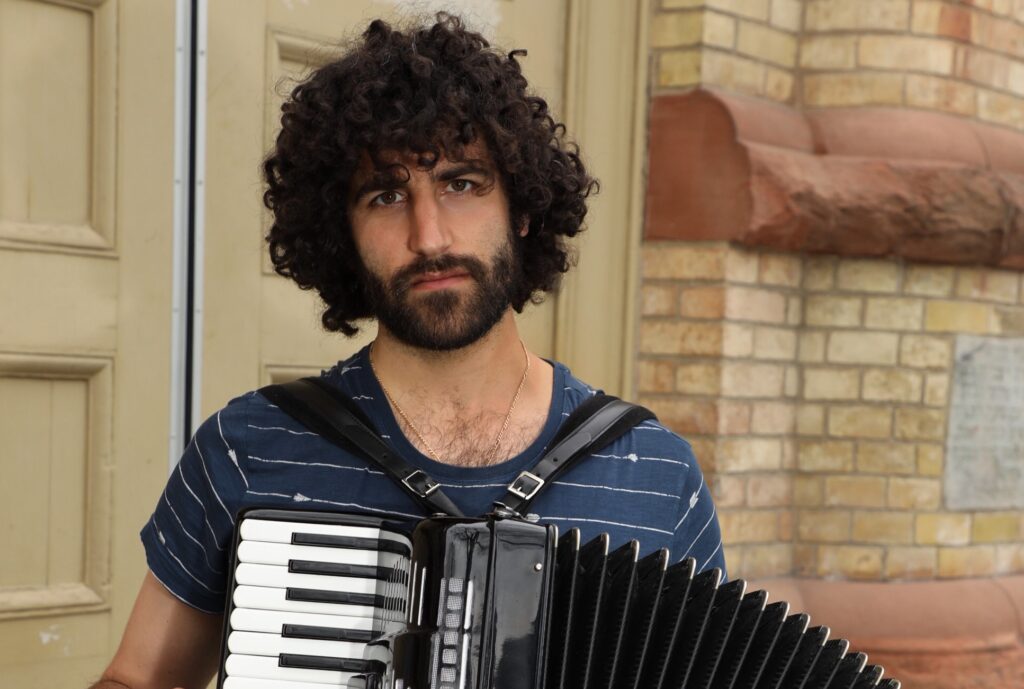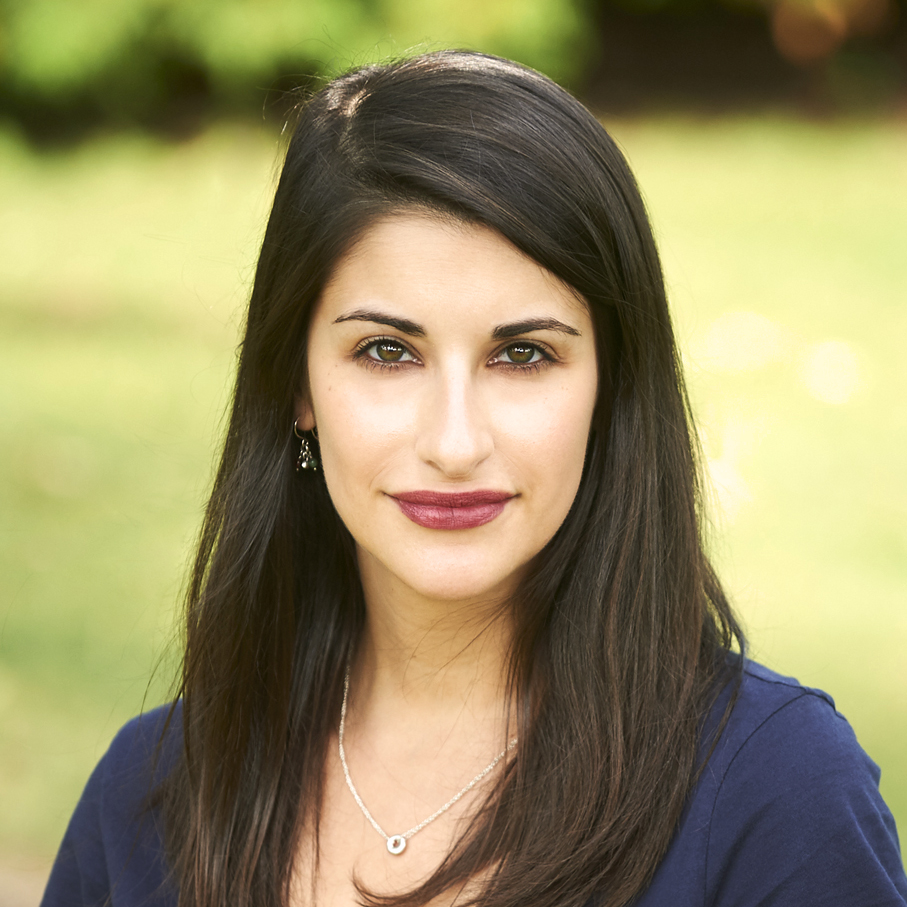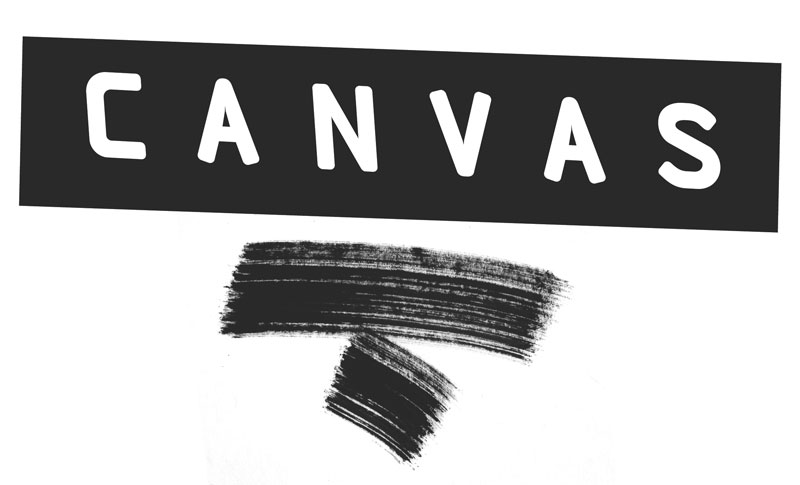Miriam Borden is a doctoral student in Yiddish Studies and very active as a speaker, teacher and researcher in the field. Her projects such as the #YiddishWordoftheWeek, as well as virtual walking tours and podcasts explore Toronto’s Jewish history in an accessible and innovative way. We caught up with her to learn more about her interest in Yiddish culture and history, her favorite spot in Kensington Market, and her collection of Yiddish children’s books.
Kultura Collective: Hi Miriam. Can you tell us a bit about you, and your work as an educator and researcher in the field of Jewish and Yiddish studies?
Miriam Borden: Hi! I am a doctoral student in Yiddish Studies at the University of Toronto. I’m passionate about all things Jewish history, especially Yiddish, so I’m doing what people like me do: pursuing a PhD in my favourite field! I spend my days and weeks immersed in a language that is the key to 1,000 years of Jewish history, a language that deciphers the otherwise largely inscrutable lives of generations of Jews from the Middle Ages to the present day. We can’t inhabit the past, but through Yiddish we can be tourists, excavators, and interpreters.
Yiddish helps us understand things like Jewish humour, absolutely—but even more so, it helps us get at the core of Jewish sadness, joy, fear, ambition, and hope. Through Yiddish, Ashkenazi Jews worked out their place in a world that was sometimes welcoming and sometimes hostile. They developed a complex worldview whose vagaries, contradictions, mysteries, simple truths, and moments of karmic justice could only be expressed in a language composed of elements of the Jewish experience, where all of these collided. In Yiddish, medieval German (and elements of other European languages) fuse with Hebrew, ancient and sacred, and Aramaic, the language of the Talmud, to create a unique expression of Jewishness shaped by the yeshiva, the synagogue, the Jewish calendar, halakha, folklore, and everyday life in the Diaspora. Studying and teaching Yiddish is one way to explore all of this and spread the libe (love).
In my research and teaching I strive to build understanding, nurture curiosity, and encourage critical perspective in the field of Yiddish language studies and Jewish literature, culture, and history. But mostly I just want folks of all ages and backgrounds to be as excited about these things as I am!
I am particularly interested in the history of Yiddish and those who shaped and were shaped by it. The classroom and library are two of my favourite settings to explore the past, but I also find that creative approaches to public education are really effective ways to broaden the tent and make that history more widely known. Through museum exhibitions, podcasts, walking tours, oral history projects, public lectures, workshops, and presentations, I explore phenomena of Ashkenazic civilization (like the Purim shpil), Yiddish poetry penned by authors of all walks of life (like factory workers on Spadina), and relationships between memory, family, history, and intergenerational Jewish experience.

KC: We get a kick out of your weekly Instagram posts for the Ontario Jewish Archives. Can you tell us a bit more about the “Yiddish Word of the Week” project?
MB: The OJA is chock-full of amazing Yiddish treasures: the full run of Toronto’s daily Yiddish newspaper Der Yidisher Zhurnal (1910-1975), photographs with hard-to-make-out Yiddish inscriptions on the back, meeting minutes from labor unions, landsmanshaftn, and other associations, posters from the Standard Theatre (the first purpose-built Yiddish theatre in Canada) at Spadina/Dundas or the Labor Lyceum at Spadina/St. Andrew, programs from annual events hosted by fraternal organizations, correspondence, and so much more. In an effort to spotlight the richness of Yiddish at the OJA and the history of Jewish life in Ontario these materials embody, we began weekly social media posts with the hashtag #YiddishWordoftheWeek in 2019. We feature one document, photo, or object with relevance to Yiddish language or culture and I choose a Yiddish word or phrase to go with it: either a word that appears in the featured item, or a word or phrase inspired by it. It’s a playful way to become more familiar with our own local Yiddish past, while broadening our knowledge of the language so necessary for understanding that past. Check out those posts every Friday on the @ontariojewisharchives Instagram and Facebook pages—they’re a lot of fun!

KC: You also work with the OJA, giving walking tours of historic Kensington Market, and more recently the virtual tour for the Scrolling Spadina website. What is your favourite Jewish place in the Market and why?
MB: The Standard Theatre stands out for me. It’s a grand old 4-story blonde brick building on the SE corner of Spadina and Dundas, and today you wouldn’t know it was such a significant and historic Jewish cultural gem unless someone told you. It opened in the summer of 1922 as a 1,200-seat Yiddish theatre in an age when the Yiddish theatre represented the height of cultural sophistication for Eastern European Jewish immigrants like those who populated cities like Toronto in the early 20th century. Originally decorated pale blue and gold inside, the theatre operated as an artistic institution as well as a social centre. As Vincent Geller, press agent for the Standard in 1933-1934 (when the theatre converted from a playhouse into a movie house), put it, “the theatre stood as a symbol, a temple where all could enter and worship as they pleased. Labor unions frequently met here to choose between strike and status quo; Zionists gathered here to hear the reports of their leaders; worshippers converted the theatre into a synagogue for the High Holy Days; politicians made generous promises at election meetings; there were simple but enthusiastic receptions to visiting poets, leaders, lecturers. Last but not least there were gala benefit performances, given under the auspices of popular lodges, when the matronly president of the Ladies’ Auxiliary would appear on the stage after the second act escorted by a committee and there would be much eulogizing and thanking all around.”
I love sharing the history of the Standard because it asks us to be imaginative. No trace of the Yiddish theatre that once flourished there exists today, so our task is to conjure it. Press coverage from the 1920s and 1930s have colourful descriptions of productions, and remembrances of the theatre’s heyday, long after it closed, give us a snapshot of Spadina Avenue as a kind of Jewish Broadway, with grand cafes where actors and their fans and friends would gather for late meals and drinks after the show.
The Standard asks us to envision a version of Spadina Avenue as few of us have ever imagined it: as the bustling, beating heart of Jewish Toronto, with a grand old theatre as its sparkling gem.

KC: In celebration of Purim, you gave a lecture about the Purim Shpiel (play) in history. Can you tell us a bit about this tradition? What fascinated you most about this format of storytelling? Did you discover anything new in your research?
MB: What fascinates me about the Purim shpil is the depth and breadth of Jewish knowledge required to really, fully understand a traditional shpil. The Purim shpil is a form of popular theatre that combines the elements of inversion and reversal that are intrinsically rooted in the holiday, with elements of carnival. Purim shpiln were historically short comic plays in Yiddish composed by artisans and yeshiva students based on parodies of Hebrew texts from the Bible, the Talmud, midrashic literature, and liturgy. The earliest Purim shpil text that we have today dates to 1697, but the purim shpil is probably at least 100 years older than that. These plays incorporated the aesthetics of the grotesque and created conflict-laden situations, which brought out subversive perspectives on contemporary matters—thereby extending the messages of the Megillah to the lives of Jews in Europe. The performers of Purim shpiln were not typically professional actors. They came from the lower levels of society—tailors, cobblers, woodworkers, and so on—and performed their shpiln during the Purim se’udah (holiday meal) in the living rooms of the balebatim (the householders, the well-off).
Understanding the traditional purim shpil, with all its parody, irony, social criticism, bawdy humour, and folklore, took a special kind of audience member. It took someone immersed in premodern Jewish society and culture, someone who understood the social status of Jews, their political status, the biblical and rabbinic texts and commentaries, Jewish laws and theology, Jewish superstitions, fears, and aspirations. That may sound like a lot, but it’s important to remember that the Purim shpil as a genre was popular theatre. People like this weren’t difficult to find.
The texture of premodern Jewish daily life was so rich and all-encompassing, touching nearly every aspect of a person’s life, from how they were educated to where they lived, who they married, what they did for work and leisure, how they raised their kids, what popular culture they consumed. (In fact, it was this totalizing nature of Jewish life that reformers in the 19th century—maskilim, proponents of the Jewish Enlightenment—sought to overturn. They found it oppressive.) This was true to a great extent up until the 19th century, when many Jews embraced modernity and secularism. With a new emphasis on the canon of European culture, many Jews lost some of the fluency required to fully understand the kind of material the Purim shpil was founded upon: deep knowledge of the Bible, midrash, and other books, familiarity with the culture of the yeshiva and Jewish folklore. Reading through a traditional Purim play from the 1700s or 1800s is one way of glimpsing what that kind of totalizing Jewish experience was like—though subverted through the lenses of parody and comedy.

KC: You are also the Chair of the Ashkenaz Foundation. What exciting things are happening in Yiddish music and performance right now?
MB: The Yiddish world is expanding in new and incredible ways right now. It’s a very exciting time! Today’s Yiddishists are grappling with some of the same questions as the Yiddishists of old: belonging, identity, our social responsibility as Jews in the world—Daniel Kahn, in Berlin, is one artist leading that charge in profound ways. In 2020, at the start of the pandemic, he and singer Sveta Kundish released “Mentshn-Fresser” (People Devourer), originally a Yiddish ballad from 1916 about tuberculosis and polio epidemics during World War I that killed swathes of people. The song, and Kahn and Kundish’s rendition of it, was, and remains, really poignant. That’s just one example of the way Yiddish artists are looking to the past to recover the gems of yesteryear and interpret them anew. In Vienna, Isabel Frey, the “Milennial Bundist,” is reviving old labor and workers’ songs with profound resonance for the present. Montreal’s own Josh Dolgin (SoCalled) has been exploring old repertoires of Yiddish musical masters, with gorgeous new arrangements of the music of Sholem Secunda, Leo Fuld, and others. (He performed some of this old-new material in a barn last summer with the Toronto Jazz Orchestra, courtesy of the Ashkenaz festival—check it out!) And then there are really playful, tongue-in-cheek reinventions of well-known classics, like Vibers (from Israel) and their cheeky (and great!) cover of the Barry Sisters’ “Bei Mir Bist Du Sheyn.” Yiddish theatre is also generating new takes on old classics, like The Mameles (a trio consisting of three actors associated with the Folksbiene Theatre) and their new release of “Abi Gezunt.”
KC: You have been an active member of the Yiddish scene in Toronto for years. What sparked this interest? What changes and shifts are you seeing happening in the community?
MB: Some people inherit silver or china or other family heirlooms. My grandparents, the sole survivors of both of their families after the war, didn’t have anything like that to hand down to me. Instead they gave me Yiddish. They gave me a language that is the key to a thousand years of Jewish life and history. Once I realized the kind of access to Jewish knowledge Yiddish offered, I was hooked. Stories, music, jokes, wisdom, poetry, theatre, history, literature—it’s all there, with a stunning timelessness and strikingly modern tone and tenor. And of course, Yiddish remains the everyday language of Hasidic communities around the world. Yiddish encapsulates an entire civilization, and learning and using the language connects me both to the past and to the present in countless ways.
This is an extraordinary time to be working with Yiddish in Toronto. The landscape is changing: historic organizations that have for years occupied the same buildings—buildings that were built for those organizations in the 1950s—are vacating those spaces because of cost or declining membership, or they are reevaluating forgotten collections of thousands of dusty Yiddish library books that today have few readers. At the same time, the Yiddish program at the University of Toronto is expanding, and there are a number of small but very dedicated Yiddish conversation and reading groups that meet weekly or monthly (and have continued to do so online all throughout the pandemic). Yiddish in Toronto isn’t going away, but it is changing. And it is remarkable to be here to witness that change and help to shape the future. I am still surprised by how much Yiddish this city holds, often quietly. I spend a lot of time salvaging Yiddish documents, records, and books, translating archival materials, and researching historical traces of things like little-known Yiddish cultural clubs from the 1920s and 1930s with headquarters in apartments along Spadina or in Kensington Market. The Yiddish story of Toronto has yet to be fully discovered and told, but I’m chipping away at it bit by bit.

KC: We know you’re busy with all these projects, as well as completing your PhD. What else are you working on right now?
MB: In 2020 I won the Honey & Wax Book Collecting Award, which recognizes women rare book collectors under 30. I won for my collection of Yiddish reading primers and textbooks for children, a collection I’m proud to say I’ve built largely here in Toronto—which speaks to that incredible Yiddish legacy here that I keep alluding to. By way of being a student of Yiddish in a city like Toronto, I’ve amassed quite a few Yiddish books. And I continue to grow my library and uncover the ways books and other archival objects can tell us so much, while being so delightful and surprising.
I’m also working with poet Adam Sol to translate the work of Shimon Nepom, a TTC streetcar conductor during the Depression who was also Toronto’s best-known Yiddish poet. For a glimpse, check out a mini-podcast I put together inspired by Nepom’s typewriter, which is held by the Ontario Jewish Archives.
And finally, before the pandemic I curated a couple of exhibitions on Yiddish language and culture at the University of Toronto and the Canadian Language Museum. Now that life is returning to its full colour, I’m planning another exhibition. I won’t say too much, but: you can bet it’ll involve Yiddish!

KC: What’s inspiring you Jewish-ly lately?
MB: POLIN Museum in Warsaw—everything they do! Also a recent collaboration between the Country Music Hall of Fame and the Weitzman National Museum of American Jewish History about the Jewish tailors of country music: it was a fun and surprising look at the way much of the aesthetics of country music can be traced back to a handful of shnayders from Eastern Europe, and I loved the way it expands the idea of what’s “American” and “classic” (hint: nothing, ever!). And on TikTok, Miriam Anzovin’s hot takes on Daf Yomi.
KC: Lightning round question!
- Latke vs sufganiyot? Latke!
- Spinning the Dreidel vs finding the afikomen? Spinning the dreidel. 3 chances to win—I mean, come on! Those are great odds.
- “Fiddler on the Roof” vs “Joseph”? “Fiddler,” of course, for all the Yiddish. Though “The Prince of Egypt” has an honoured place in my heart.
Miriam Borden is a PhD candidate in Yiddish Studies at the University of Toronto, where she teaches Yiddish language and culture classes. Beyond the university, she is actively involved in preserving and publicizing the Yiddish history of Toronto. She works closely with the Ontario Jewish Archives on a number of Yiddish initiatives, including creating social media posts featuring a #YiddishWordoftheWeek, leading walking tours of Kensington Market, and translating Yiddish materials from the collection. She has been a fellow in the oral history and Yiddish pedagogy programs at the Yiddish Book Center in Amherst, Massachusetts. And she is currently leading a project to catalogue and preserve over 2,000 Yiddish books housed at the Morris Winchevsky Centre. In addition, Miriam is currently translating the poetry of Shimon Nepom, the College Street streetcar conductor who was Toronto’s most prominent Yiddish poet in the 1930s, and working on a dissertation about the great Canadian Yiddish folksong collector Ruth Rubin. She is also a juror for the 2022 Canadian Jewish Literary Awards.







